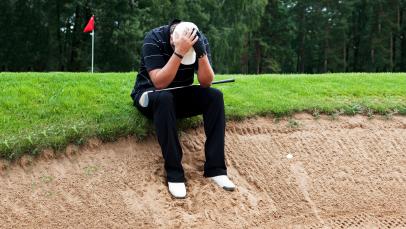Rules of Golf
Rules of Golf Review: How do I find my 'nearest point of relief'?

Pro golfers often find themselves in situations where they are entitled to take a free drop but need to find the nearest point of relief. Here's how they—and you—should do it.
Ryan Young
It's a term you hear quite often when you watching a pro golf broadcast: nearest point of relief. And it literally means what it sounds like. If you're taking free relief for one of the various reasons you’re allowed to in the Rules of Golf—ball on a cart path, next to a sprinkler head, in an abnormal ground condition like ground under repair, in casual water, etc.—you need to find the spot where you could make a stroke at your ball without any interference from the thing you are taking relief from. Your lie, stance and swing should not be impeded in any way—it’s known as taking complete relief. If any or all of them are still impacted by the lie, you're playing from the wrong place. Also, that spot cannot be closer to the hole than where your ball originally came to rest. It's all there in Rule 16.
OK, that's where you might think this conversation should end. But it's not that simple. Things such as whether you are playing left-handed or right-handed matter. So does the location of that nearest point (for instance, it can't be on another hole's putting green). The nearest point also does not guarantee that you will get a good lie for your next shot. As golf’s governing bodies, the USGA and R&A, like to say, it's not the "nicest" point, it's the nearest point. Cute.
Suffice it to say, when determining where that nearest point is, you have ask yourself, How do I intend to play my next shot? For example, if you're a righty, and your ball is in the dead middle of a cart path (see J.B. Holmes’ photo above), your nearest point of relief would likely be to the left of the path. Why? Think about it. If you were to drop on the right side, to be fully clear of the path, the distance would be at least a few feet away from the pavement. On the left side, you could stand and swing at a ball only a few inches from the path. This diagram below (courtesy of the USGA), should further clarify your nearest point of relief.

It's also mandatory to decide what club you are going to use for your next shot, what stance you will take, your intended swing and line of play. All of this has to be factored. You don't actually have to simulate this before playing your next shot, but it's recommended to make sure you got the spot right.
The final thing to remember: You don't have to take relief from any of the conditions listed above. You probably have seen players hit shots off the cart path because taking the relief would mean being in a worse position than they currently are in. It might be worth it to put scrape marks on your wedge to save a stroke or two.


